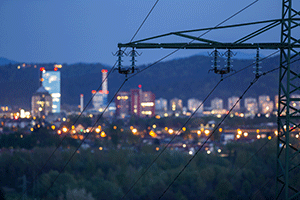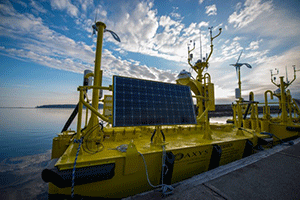Energy Efficiency and Renewable Energy About
Enabling the efficient use of energy resources, reducing petroleum consumption, and accelerating the use of renewable sources of electricity covers a broad spectrum – buildings, biomass, and vehicles – all of which have different challenges. We bring an equally diverse set of capabilities and expertise to these challenges.

Buildings account for about 40 percent of our nation's energy use and nearly 40 percent of our carbon dioxide emissions. With over three decades of experience in buildings energy, we deliver energy savings in all stages of buildings-related research, technology development, and deployment.
Our contributions are dramatically improving the energy efficiency of new and existing buildings and reducing their environmental footprint. Some of our work includes:
- Buildings-Grid Integration: We support a vision where sensors, control systems, and other technologies work together to manage energy use for buildings and a more efficient, flexible grid. With deep roots in advanced controls, energy analysis, and smart grid research, our expertise covers a range of key disciplines, including transactive control, building control systems, data analytics and modeling, energy storage, and grid services.
- Energy Codes: We lead the U.S. Department of Energy's Building Energy Codes Program, which saves commercial building owners an estimated 300 trillion Btu of primary energy annually. Our work with BECP draws upon applied building science, whole-building energy simulation, and analysis capabilities to support development of effective codes and stricter energy standards.
- Experimental Homes: We perform experiments in a matched pair of lab homes to evaluate technologies that can be added to a home after construction to improve efficiency. The homes offer a side-by-side ability to test and compare new ideas and approaches that are applicable to site-built as well as manufactured homes in the region and nationwide.
- Living Laboratory: For our own campus operations at PNNL, the Building Operations Control Center (BOCC) serves as a portal for people to connect to intelligent infrastructure from the smart grid, down to buildings, systems and components. Real-time data is used to make informed decisions resulting in reduced facility operation cost.
- Buildings Re-tuning: By partnering with building owners and operators over the past several years, we've developed and implemented strategies for retrofitting and re-tuning building equipment, improving operation and maintenance practices, and introducing automation of building systems.
- Advanced Lighting: Our researchers support several DOE lighting programs and partner closely with industry to improve lighting technology. Through lab testing and field evaluations, we identify ways to make lighting work better and do more for us.
Join our mailing list to stay informed on our work in building technologies.

Our country is investing in clean energy technologies that harness renewable sources of electricity. At PNNL, we are accelerating the use of renewable energy in these areas:
- Hydropower: We leverage our expertise in fish passage, turbine design, grid integration, and basin scale assessment to improve the efficiency and environmental performance of the nation’s largest source of renewable energy. Hydropower provides 6-8 percent of electricity in the United States, but to be successful in the future, new and existing hydropower systems need to be more efficient, more cost effective, and environmentally sustainable.
- Wave & Tidal Power: Forces created by the ocean have the potential to produce 25 perfect of the electricity used annually in the United States. Our researchers are helping to mature marine and hydrokinetic energy as a viable renewable energy option by developing precise and efficient means for measuring energy potential.
- Solar Power: We are providing key breakthroughs in solar technology through new projects in thin film photovoltaics and thermal storage for concentrating solar power.
- Geothermal Energy: Our subsurface modeling capabilities help characterize potential geothermal energy sites and evaluate their capacity for long-term energy production. We have also developed technologies for capturing, extracting, and converting heat from untapped geothermal sources. Finally, we are leveraging our carbon capture and sequestration work to understand the geochemistry of carbon dioxide to potentially combine CO2 sequestration with enhanced geothermal systems.
- Wind Power: We leverage our expertise in environmental sciences, atmospheric sciences, and grid management to develop tools and methodologies that enable a high penetration of variable generation into our grid system. We explore wind resource characterization through research projects and collaborative efforts, demonstrate an R&D approach to assessing environmental effects, and use our unique facilities and key partnerships for offshore wind energy.
Join our mailing list to stay informed on our work in renewables.

Widespread use of petroleum among vehicles, planes, trains, and ships continues to harm our environment. As a whole, the transportation sector accounts for about one third of our nation's greenhouse gas emissions. At PNNL, we are committed to enabling the reduction of petroleum use with innovative ideas and approaches. Our work includes:
- Vehicle Batteries: Hybrid vehicles, plug-in electric vehicles, and fuel-cell powered vehicles can significantly reduce fuel use, but they are limited by the lack of an effective way to store energy for long distance travel. Our research focuses on removing this barrier.
- Lightweight Materials: To improve fuel economy, we are developing lightweight materials for cars and trucks as well as related manufacturing processes. We created a friction stir welding technique that effectively joins aluminum sheets of dissimilar thickness.
- Biofuels: We are helping drive the shift from petroleum to bio-based fuels by developing the scientific and engineering foundations for converting biomass to biofuels that are infrastructure ready. Biofuels are fuels derived from plant materials, or biomass. Infrastructure-ready biofuels can use existing petroleum refinery and deployment capabilities with little new investment. We work with advanced biotechnology and thermal processes to produce alcohols, like ethanol, and other intermediates, like pyrolysis or bio-oils. And we are developing technologies to convert these intermediates into the next generation of hydrocarbon fuels, including gasoline, diesel and jet fuels.
- Vehicle Exhaust Emissions: We developed the technology used by catalytic converters to convert automobile exhaust emissions to non-toxic materials. We're predicting an improving catalytic device performance with our advanced combustion engine research.
Join our mailing list to stay informed on our work in vehicle technologies and biofuels.
